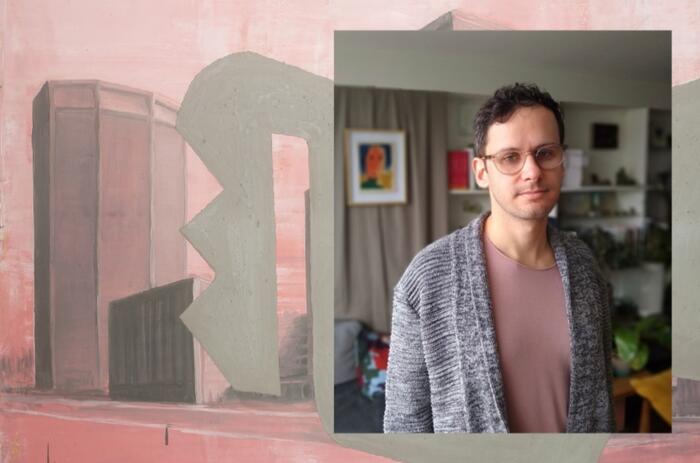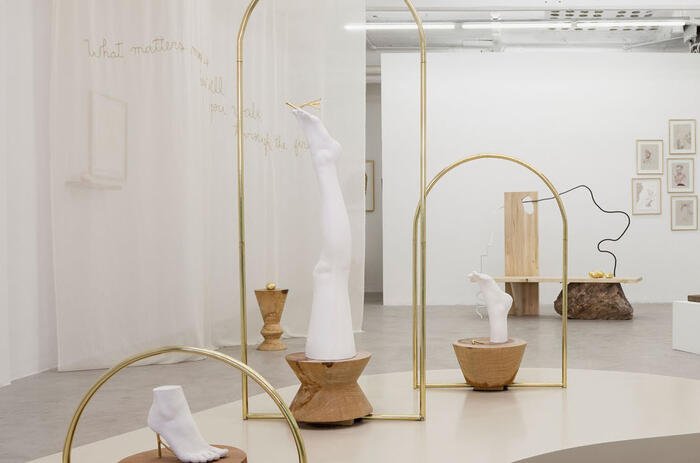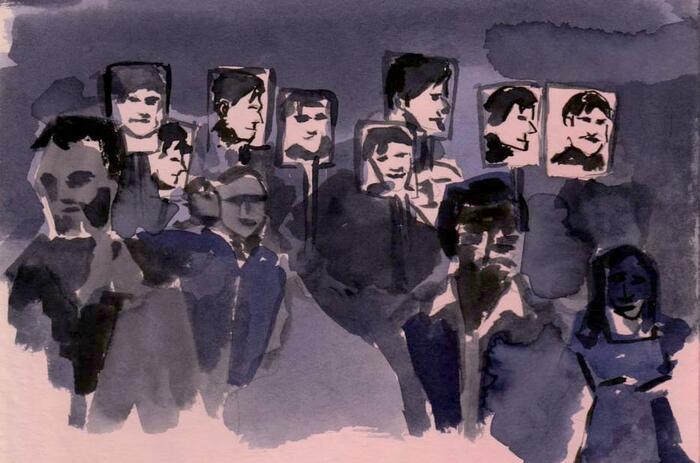LAST DAYS OF "ACTOS PREPARATIVOS: NEW LATIN AMERICAN FIGURATION"
The Chilean artist Pablo Linsambarth (Santiago de Chile, 1989) exhibits in VIGIL GONZALES’ Online Viewing Room (Peru). The exhibition aims to account for a new figurative aesthetic in development in the American continent. Taking into consideration the historical and social framework that surrounds Linsambarth's artistic impulses, the paintings on display are part of an equally interesting dialogue on an aesthetic, conceptual and political level.

Matías Helbig wrote about the exhibition:
Pablo Linsambarth’s paintings are based on the mechanisms of storytelling and are fundamentally configured as a reflection of oral tradition as a device of cultural transmission. In the Chilean artist’s imaginary, family memory and urban legends intermingle with everyday iconography in a sort of pictorial collage. The result: the composition of an urban and contemporary folklore. The oil paintings reproduce the spaces of family memory, the mythological space of the Pudahuel from his childhood and the convulsive rhythm of urban life in Santiago de Chile; he brings them all together in a timeless dialogue that shifts the qualities of space to transform them into scenarios. In canvases open to the games of fiction.
This movement that Linsambarth makes in his works is not gratuitous. The great theme that led him to the composition of drawings and paintings, in the first place, is a specific family and historical event. In the mid-1980s until the early 1990s, Linsambarth’s mother, affiliated with the Revolutionary Left Movement (MIR) in Chile, was forced to live in hiding from the Pinochetism persecution. As a consequence, the family archive (mainly photographs and letters) from those years is characterized by her absence. For the artist, the family images presented an emptiness that could only be deceived, manipulated, through fiction, that is to say, through the creative act. From that point on, he appropriates the archive and begins to reproduce the photographs, occupying the spaces with the figure of his mother and, of course, with the effects of memory, filling a genealogy with meaning and time through the pictorial image. A gesture, by the way, that refers to the advice Stéphane Mallarmé gave his friend Éduoard Manet not to paint objects, things, but what they produced in him. Linsambarth does not paint the past, but the effects it arouses in his imagination, composing the present.
On the other hand, the other two worlds that converge in Actos Preparatorios are the legend and the underground, the street. In the first case, the Chilean artist appropriates the myth of the Culebrón de Pudahuel, a legend of the community in which he grew up and which manifests itself in the paintings through certain religious symbologies such as the crucifixes or the mephistophelic horns of a businessman. This theme also functions, as a narrative of memory, as a narrative that shapes and manipulates the vision of reality.
In the second case, the presence of gangs and a certain aesthetic that oscillates between sportswear and the classic costume of those who work in organized gangs; the neighborhood barbershop; the presence of soccer and boxing -as popular sports but also as favored for betting and corruption- are all elements that end up impregnating a certain strangeness in Linsambarth’s imaginary. His works blur temporal and spatial boundaries and propose a world where everything intersects and happens simultaneously.
Taking into consideration the historical and social framework that surrounds Linsambarth’s artistic impulses, the paintings exhibited in Vigil Gonzales’ Online Viewing Room under the title Actos Preparatorios (Preparatory Acts) are part of a very interesting dialogue at an aesthetic level. The framing of the scenes, conceived from a photographic perspective, winks at David Hockney (UK, 1937); the presence of emptiness in the silences and the distances established by some of the characters seem a tribute to the scenes of Edward Hopper (USA, 1882-1967); the approach of mundane and contemporary spaces, the bathers, for example, evoke certain paintings by Eric Fischl (USA, 1948); the presence of the lumpen world and the configuration of certain interiors refer to Pablo Suárez (Argentina, 1937-2006). And in consonance with the work of Linsambarth’s contemporaries, the oil paintings also trace relationships: the use of color and the introduction of a street aesthetic, of the popular culture of our century, for example, is closely linked to certain aesthetic treatments of Maxwell Alexandre (Rio de Janeiro, 1990); or the presence of rarefied figures, leading the paintings towards unavoidable narrative potentials for the spectators, is very close to the composition of the characters that Ivana de Vivanco (Lisbon, 1989) develops in her painting.
Having made this journey, it only remains to say that Pablo Linsambarth’s painting is a painting that demands a pact with the spectator. This is a pact of fiction: to accept the rules of his narrative. Only in this way is it possible -as it happens in every good novel, in every foundational story- to see the world in this synchronic and borderless work proposed by the young artist.
Pablo Linsambarth lives and Works in Santiago de Chile, where he is a teacher and visual artist. He is Graduated in Plastic Arts from the University of Chile and Master in Arts, mention in Visual Arts from the same institution. In 2016 he was awarded a scholarship by the AADK Network platform based in Spain to carry out a Project and Artistic Residence in the city of Murcia. That same year, he obtained funding from the same organization to produce a Video Documentary in Morocco (Title: Travel as an immigrant, live as a tourist). He also made an artistic intervention in Venice, Italy and received a commissioning invitation to Manifesta 11 in Zurich, Switzerland. In 2003 he obtained the Young Art Award from the Municipality of Las Condes (Chile) and the South African Embassy. Pablo has had solo shows in Spain, cuba, Chile, Germany, United Kingdom and hong Kong.







